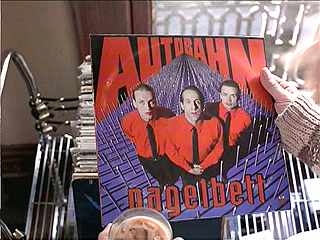The Penguin Guide to Jazz on CD is the definitive printed resource for jazz lovers. It is a brilliantly curated collection of reviews and general aesthetic advice put together by Richard Cook and Brian Morton, an extraordinary cultural service they have been performing for more than 15 years now. It is to the jazz fan's armory what David Thompson's New Biographical Dictionary of Film is to the film buff's. Only without perhaps quite the same volume of page-turning salacious gossip.
An adventure in the unknowable
The 9th edition will be the fourth copy of this massive book that I will own, with other editions strewn in storage lockers across the globe like obelisks marking my places of former habitation. And, of course, I can't possibly get rid of those editions, because they contain reviews of recordings which are no longer actively "in print", but which might still be available -- or might be rereleased in the time before the next edition. Or (imagine this) released digitally without any corresponding physical presence whatsoever by an enterprising record label looking to earn money from its back catalog with very little capital investment.
And there's more -- this, from the Wikipedia page about the guide:
Due to the increasing numbers of CDs on the market, space limitations and depth of coverage have increasingly become an issue: in the 7th edition, for instance, the index was dropped to save space, but it was restored in the 8th edition (but a number of entries were dropped or shortened to make room for it).
So it's always a contingent and partial exercise. It's a real-world experiment with the unknowable; a test of your stamina contrived by the publishing industry and the recording industry to see whether you are up to the challenge.
Are you worthy? Do you want it enough? Do you deserve the musical pleasures that you think you want? Will they still be there when you realize you want them? Will they have been reissued in thirteen different editions, each of them offering superior remastering and spectacular studio outtakes?
A problem of organization
Ultimately, however, the problem with books of this type is that their organizational assumptions are now fundamentally out of date. You have to navigate by artist, which can be a pain -- there's no way to see the highest-rated albums by genre, search by sidemen, and so on. And obviously there's no preview link to listen to parts of the album or actually download the album(s) directly should you want to purchase.
This is obviously stupid and must be stopped. Users should be able to tag entries by artists, participants, genre, rating, or anything else they want; they should be able to make use of links to direct download, and make links themselves. You could then search for a combination of tags -- for example, 4-star hard-bop albums featuring Hank Mobley. And then you could download like a crazy download monkey.
The same goes, obviously, for any other type of entertainment guide on the market. Videohound -- you're next. Release that fine content from the silo of your website.
Of course, I will buy the Penguin Guide. Even though I would much, much rather spend more money for access to an electronic version that integrated seamlessly into iTunes and any other online music service of which I might make use.
(I will also continue to buy jazz CDs, if only because iTunes can be so dreadful at distinguishing top-quality remasters from their poor initial digital iterations. That isn't to say that I'm not just going to rip them anyway, to the horror of audio purists everywhere. But it does illustrate just how godawful those early CD masters were. Apparently there are two bass parts at the outset of Bitches Brew -- who knew? And the vibraphones on Idle Moments really should shimmer and throb, rather than sounding like bland aural wallpaper as if they were recorded in some appalling bar at the front of a dive motel.)
Entertainment guides should guide you to entertainment. Repeatedly.
I've recently rediscovered Charles Shaar Murray's guide to Blues on CD, a book published in the mid-90s which was invaluable to me when I was first trying to get beyond Robert Johnson and John Lee Hooker. Part of the frustration back then -- aside from the fact that I could afford a fraction of what was recommended -- was the difficulty in finding this stuff. In hindsight, actually, it seems astonishing that I could find a compilation of Otis Rush's mid-50s Cobra sides in a record store in a suburban English town. I'm quite sure that I couldn't find anything nearly as specialized in any of Toronto's largest record stores today (particularly post-Sam's). But I certainly couldn't find Furry Lewis or Ishman Bracey.
Nowadays, I am able to find much of what I want on iTunes -- and most of it in the form of the individual tracks I want to hear, rather than the dull filler that was inevitably recorded as radio bait and pads out most of those CD compilations that I bought when I was 18.
Now, if only Charles Shaar Murray's guide was actually a constantly updated, organically evolving online resource, rather than a one-off produced according to the whims and routines of the publishing industry?


